
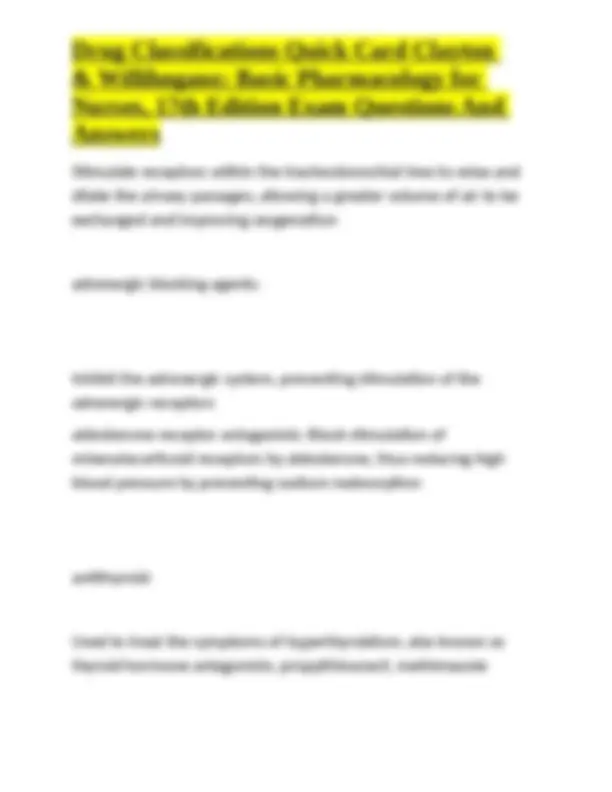
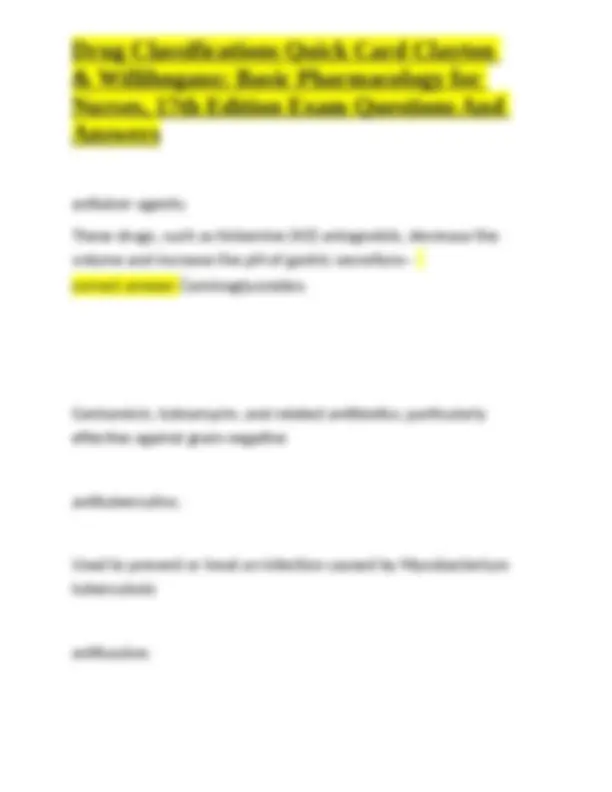
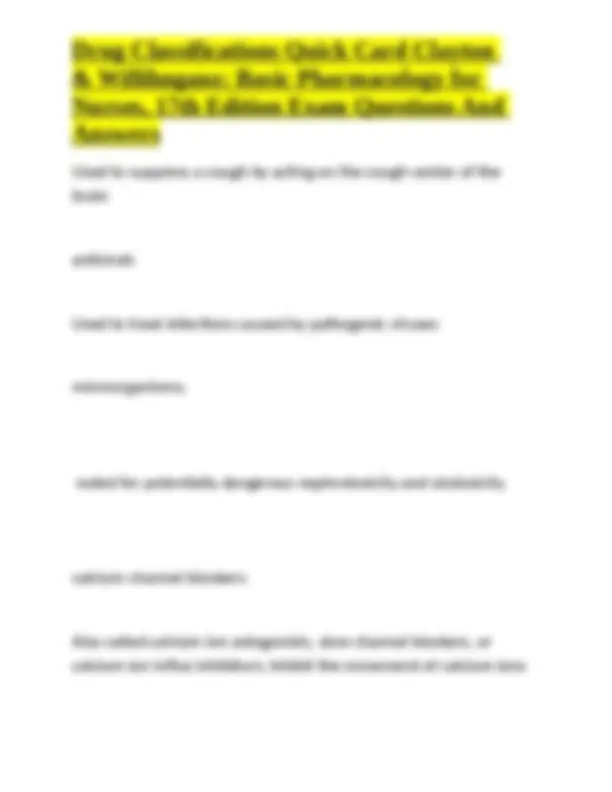
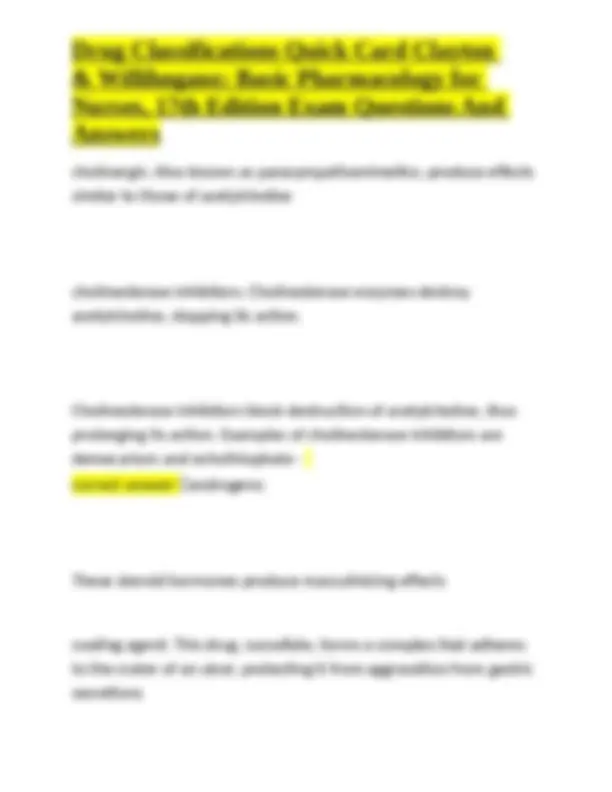
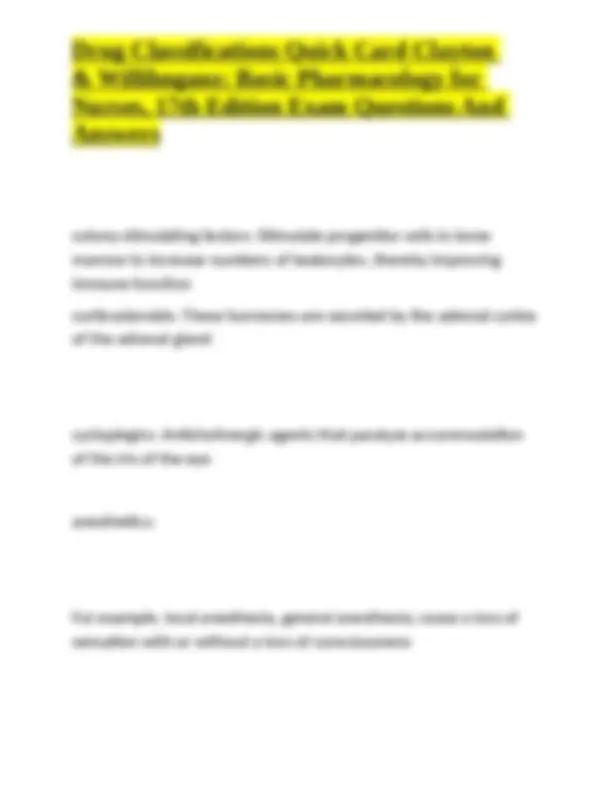
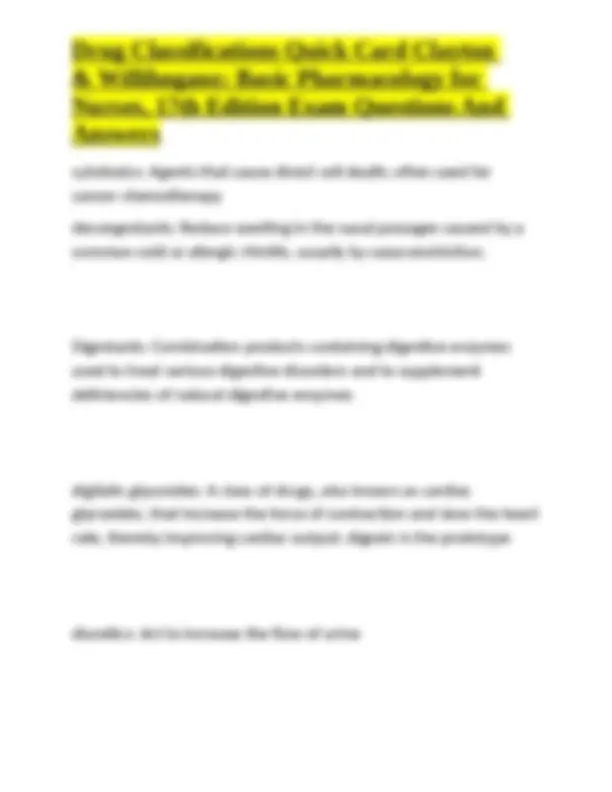
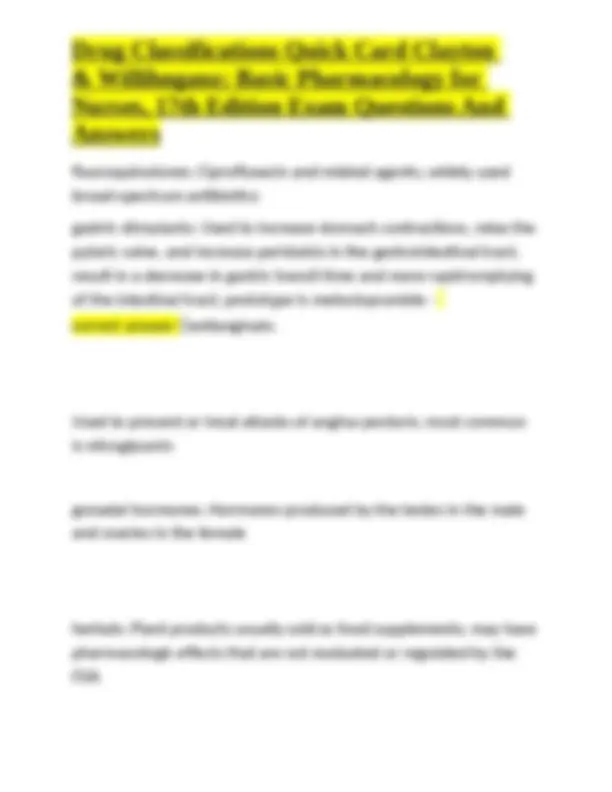
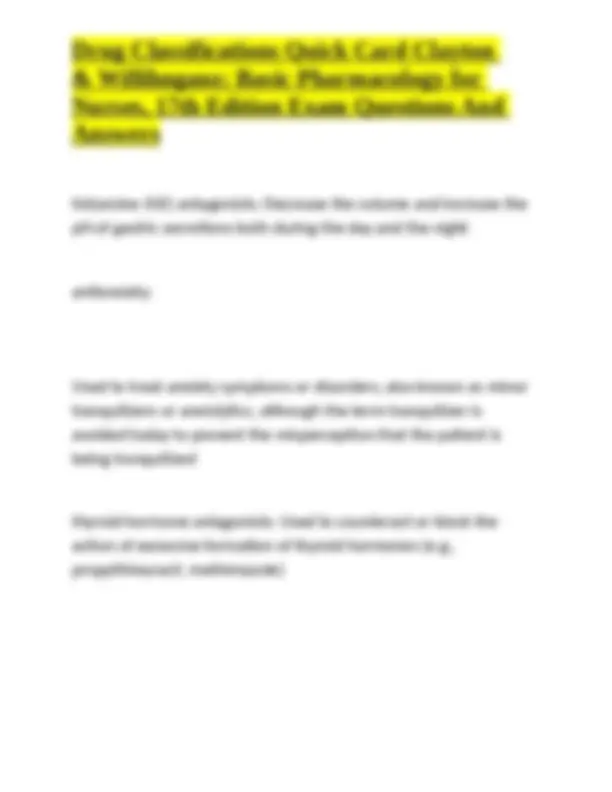
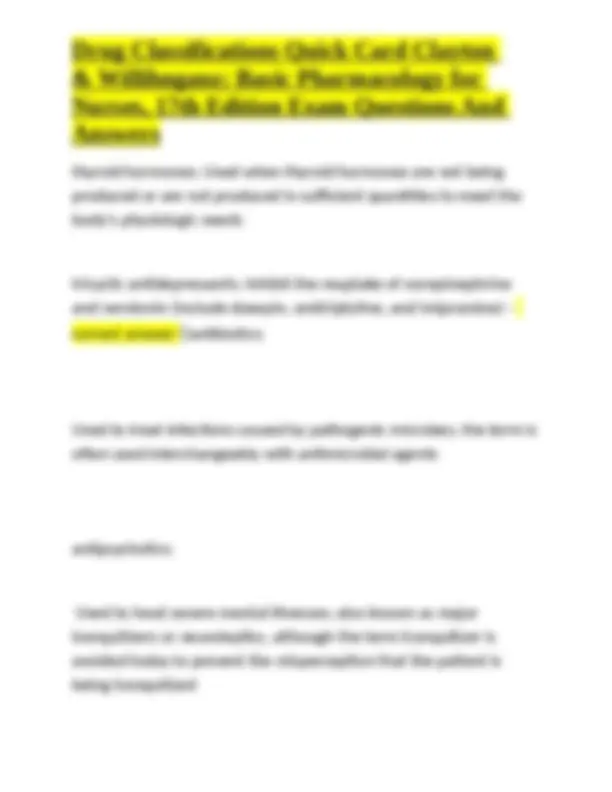
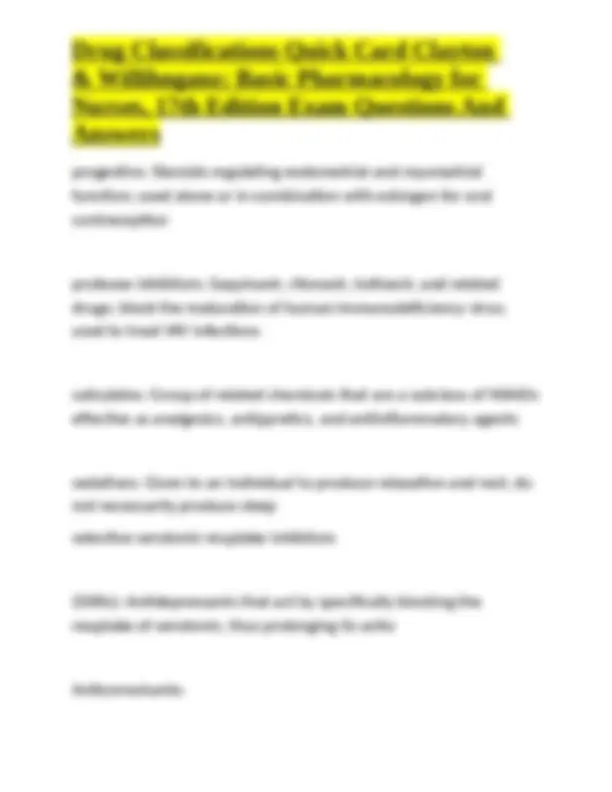
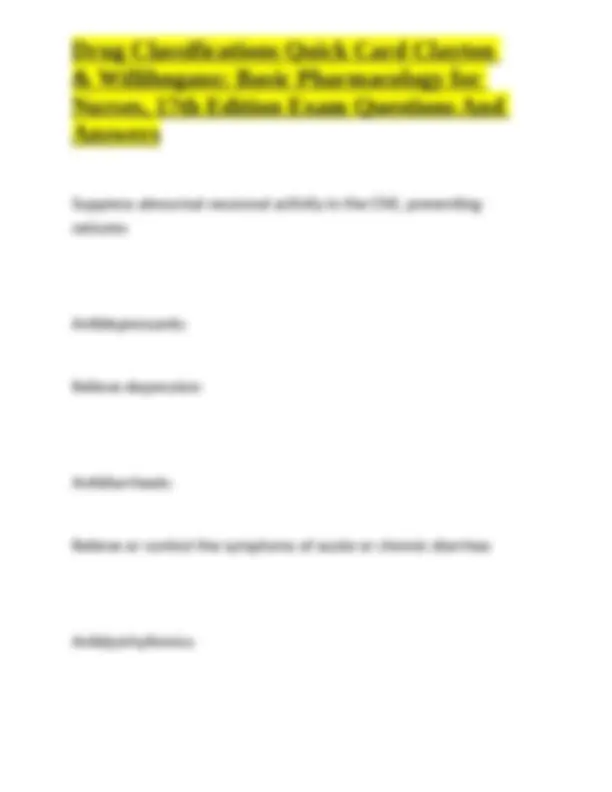
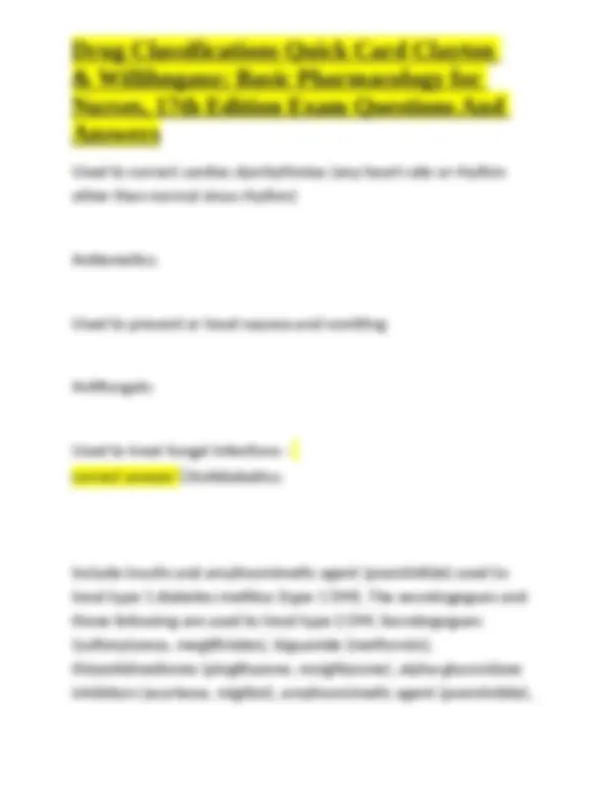
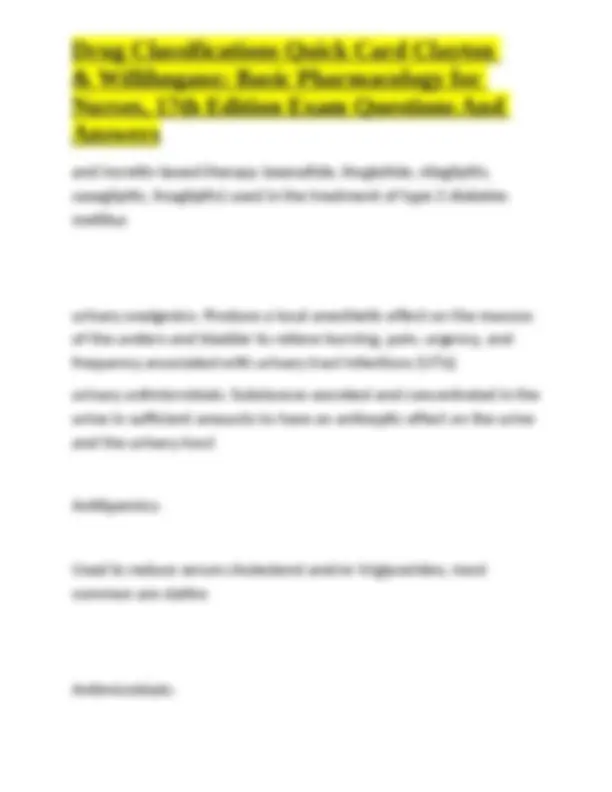
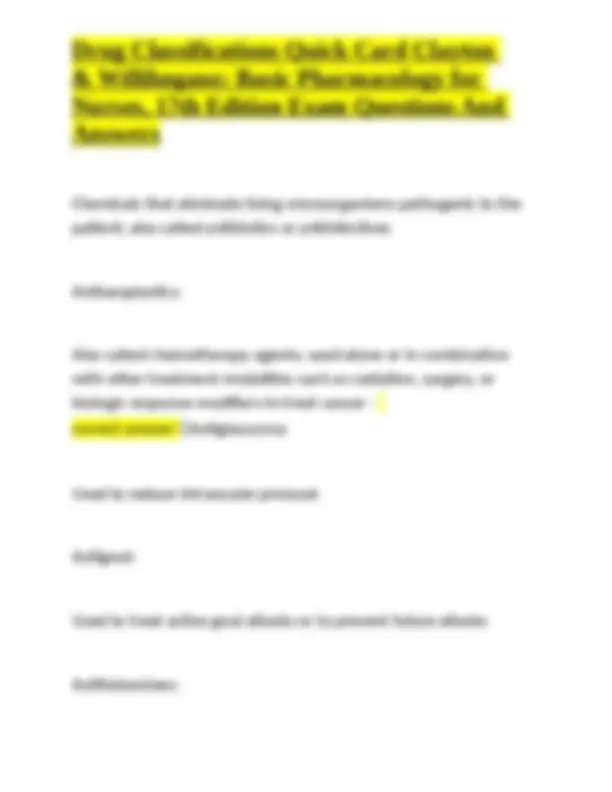
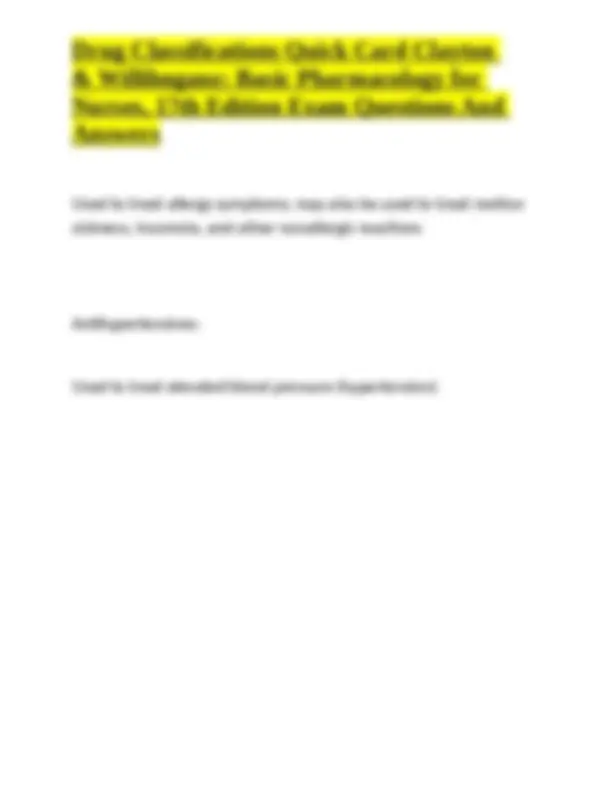


Study with the several resources on Docsity

Earn points by helping other students or get them with a premium plan


Prepare for your exams
Study with the several resources on Docsity

Earn points to download
Earn points by helping other students or get them with a premium plan
Community
Ask the community for help and clear up your study doubts
Discover the best universities in your country according to Docsity users
Free resources
Download our free guides on studying techniques, anxiety management strategies, and thesis advice from Docsity tutors
Drug Classifications Quick Card Clayton & Willihnganz: Basic Pharmacology for Nurses, 17th Edition Exam Questions And Answers
Typology: Exams
1 / 23

This page cannot be seen from the preview
Don't miss anything!
















ACE inhibitors: Prevent the synthesis of angiotensin II, a potent vasoconstrictor; used to treat hypertension, heart failure and kidney disease acetylcholinesterase inhibitors: Promote the accumulation of acetylcholine, resulting in prolonged cholinergic effects antipyretics: Used to reduce fevers associated with a variety of conditions; most common are aspirin, acetaminophen, and ibuprofen antispasmodics: Actually anticholinergic agents beta blockers: Inhibit the activity of sympathetic transmitters, norepinephrine and epinephrine; used to treat angina, dysrhythmias, hypertension, and glaucoma - correct answer ✅adrenergic:
Produce effects similar to the neurotransmitter norepinephrine antiparkinson's: Used in the treatment of Parkinson's syndrome and other dyskinesias antiplatelets: Prevent platelet clumping (aggregation), thereby preventing an essential step in formation of a blood clot; most common are aspirin, clopidogrel and prasugrel bronchodilators:
antiulcer agents: These drugs, such as histamine (H2) antagonists, decrease the volume and increase the pH of gastric secretions - correct answer ✅aminoglycosides: Gentamicin, tobramycin, and related antibiotics; particularly effective against gram-negative antituberculins: Used to prevent or treat an infection caused by Mycobacterium tuberculosis antitussive:
Used to suppress a cough by acting on the cough center of the brain antivirals Used to treat infections caused by pathogenic viruses microorganisms; noted for potentially dangerous nephrotoxicity and ototoxicity calcium channel blockers: Also called calcium ion antagonists, slow channel blockers, or calcium ion influx inhibitors; inhibit the movement of calcium ions
Hypnotics; Used to produce sleep glucocorticoids: Also known as adrenocorticosteroids; are used to regulate carbohydrate, fat, and protein metabolism thrombolytics: A specific group of drugs (alteplase, anistreplase, streptokinase, urokinase, tenecteplase) given to dissolve existing blood clots analgesics: Narcotic and nonnarcotic; relieve pain without producing loss of consciousness or reflex activity
cholinergic: Also known as parasympathomimetics; produce effects similar to those of acetylcholine cholinesterase inhibitors: Cholinesterase enzymes destroy acetylcholine, stopping its action. Cholinesterase inhibitors block destruction of acetylcholine, thus prolonging its action. Examples of cholinesterase inhibitors are demecarium and echothiophate - correct answer ✅androgens: These steroid hormones produce masculinizing effects coating agent: This drug, sucralfate, forms a complex that adheres to the crater of an ulcer, protecting it from aggravation from gastric secretions
cytotoxics: Agents that cause direct cell death; often used for cancer chemotherapy decongestants: Reduce swelling in the nasal passages caused by a common cold or allergic rhinitis, usually by vasoconstriction. Digestants: Combination products containing digestive enzymes used to treat various digestive disorders and to supplement deficiencies of natural digestive enzymes digitalis glycosides: A class of drugs, also known as cardiac glycosides, that increase the force of contraction and slow the heart rate, thereby improving cardiac output; digoxin is the prototype diuretics: Act to increase the flow of urine
emetics: Used to induce vomiting - correct answer ✅angiotensin II receptor antagonists: Also known as ARBs (angiotensin receptor blockers); act by binding to angiotensin II receptor sites, preventing angiotensin II (a very potent vasoconstrictor) from binding to receptor sites in vascular smooth muscle, brain, heart, kidneys, and adrenal gland, thus blocking the blood pressure-elevating and sodium-retaining effects of angiotensin II HMG-CoA reductase enzyme inhibitors: Also known as the statins; antilipemic agents that inhibit hydroxymethyl-glutaryl coenzyme A (HMG-CoA) reductase enzyme, the enzyme that stimulates the conversion of HMG-CoA to mevalonic acid, a precursor in the biosynthesis of cholesterol, thus reducing the potential for atherosclerosis
fluoroquinolones: Ciprofloxacin and related agents; widely used broad-spectrum antibiotics gastric stimulants: Used to increase stomach contractions, relax the pyloric valve, and increase peristalsis in the gastrointestinal tract; result in a decrease in gastric transit time and more rapid emptying of the intestinal tract; prototype is metoclopramide - correct answer ✅antianginals: Used to prevent or treat attacks of angina pectoris; most common is nitroglycerin gonadal hormones: Hormones produced by the testes in the male and ovaries in the female herbals: Plant products usually sold as food supplements; may have pharmacologic effects that are not evaluated or regulated by the FDA
histamine (H2) antagonists: Decrease the volume and increase the pH of gastric secretions both during the day and the night antianxiety: Used to treat anxiety symptoms or disorders; also known as minor tranquilizers or anxiolytics, although the term tranquilizer is avoided today to prevent the misperception that the patient is being tranquilized thyroid hormone antagonists: Used to counteract or block the action of excessive formation of thyroid hormones (e.g., propylthiouracil, methimazole)
uricosuric agents: Act on the tubules of the kidneys to enhance the excretion of uric acid anticholinergics: Block the action of acetylcholine in the parasympathetic nervous system; also known as cholinergic blocking agents, antispasmodics, and parasympatholytic agents serotonin antagonists: Used to block serotonin; prevent emesis induced by chemotherapy, radiation therapy, and surgery statins (HMG-CoA reductase inhibitors): Block the synthesis of cholesterol stool softeners or fecal softeners: Draw water into the stool, thereby softening it
sympatholytics: Interfere with the storage and release of norepinephrine and epinephrine sympathomimetics: Mimic the action of dopamine, norepinephrine, and epinephrine thrombolytics: A specific group of drugs (alteplase, anistreplase, streptokinase, urokinase, tenecteplase) given to dissolve existing blood clots - correct answer ✅anticoagulants: Prevent the formation, enlargement, or extension of blood clots. Do NOT dissolve existing bloodclots.
Suppress abnormal neuronal activity in the CNS, preventing seizures Antidepressants: Relieve depression Antidiarrheals: Relieve or control the symptoms of acute or chronic diarrhea Antidysrhythmics:
Used to correct cardiac dysrhythmias (any heart rate or rhythm other than normal sinus rhythm) Antiemetics: Used to prevent or treat nausea and vomiting Antifungals: Used to treat fungal infections - correct answer ✅Antidiabetics: Include insulin and amylinomimetic agent (pramlintide) used to treat type 1 diabetes mellitus (type 1 DM). The secretogogues and those following are used to treat type 2 DM. Secretogogues (sulfonylureas, meglitinides), biguanide (metformin), thiazolidinediones (pioglitazone, rosiglitazone), alpha-glucosidase inhibitors (acarbose, miglitol), amylinomimetic agent (pramlintide),